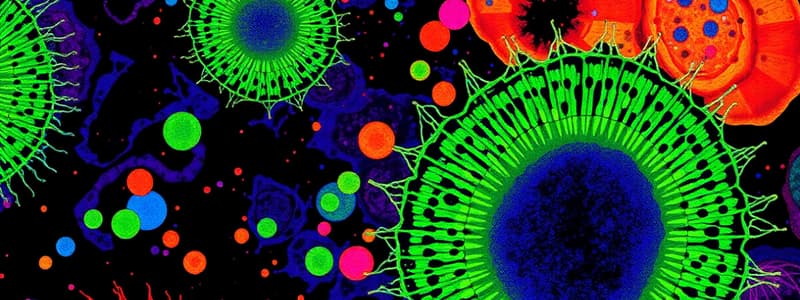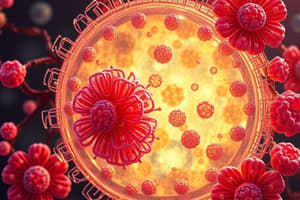Podcast
Questions and Answers
If a cell's ability to produce ribosomes is compromised, which of the following nuclear structures is most likely affected?
If a cell's ability to produce ribosomes is compromised, which of the following nuclear structures is most likely affected?
- Nucleolus (correct)
- Nucleoplasm
- Chromatin
- Nuclear envelope
Which of the following best describes the relationship between chromatin and chromosomes?
Which of the following best describes the relationship between chromatin and chromosomes?
- Chromatin is composed of DNA and proteins and condenses to form chromosomes. (correct)
- Chromosomes control gene expression, while chromatin is responsible for DNA packaging.
- Chromatin packages and organizes chromosomes.
- Chromosomes are the basic units that make up chromatin.
A researcher is studying the transport of molecules within the nucleus. Which component of the nucleus is MOST directly involved in this process?
A researcher is studying the transport of molecules within the nucleus. Which component of the nucleus is MOST directly involved in this process?
- Nuclear envelope
- Chromatin
- Nucleoplasm (correct)
- Nucleolus
Which of the following characteristics is exclusive to plant cells, and NOT found in animal cells?
Which of the following characteristics is exclusive to plant cells, and NOT found in animal cells?
A cell is unable to regulate gene expression effectively. Which nuclear component is MOST likely malfunctioning?
A cell is unable to regulate gene expression effectively. Which nuclear component is MOST likely malfunctioning?
Which of the following structures is NOT present in both animal and plant cells?
Which of the following structures is NOT present in both animal and plant cells?
If a cell were unable to perform proper protein modification and sorting, which organelle is most likely malfunctioning?
If a cell were unable to perform proper protein modification and sorting, which organelle is most likely malfunctioning?
A scientist observes a cell actively synthesizing lipids. Which part of the endoplasmic reticulum is most likely involved in this process?
A scientist observes a cell actively synthesizing lipids. Which part of the endoplasmic reticulum is most likely involved in this process?
Which function would be directly affected if the nuclear envelope were damaged?
Which function would be directly affected if the nuclear envelope were damaged?
A certain poison disrupts the function of mitochondria. Which of the following processes would be most immediately affected?
A certain poison disrupts the function of mitochondria. Which of the following processes would be most immediately affected?
A plant cell maintains its turgor pressure due to the function of which organelle?
A plant cell maintains its turgor pressure due to the function of which organelle?
The nucleus directly controls protein synthesis by performing which of the following actions?
The nucleus directly controls protein synthesis by performing which of the following actions?
Which cellular component's primary function is to provide a medium for molecular transport within the cell?
Which cellular component's primary function is to provide a medium for molecular transport within the cell?
Flashcards
Nucleoplasm
Nucleoplasm
The jelly-like substance inside the nucleus that suspends organelles and facilitates molecule transport.
Chromatin
Chromatin
A complex of DNA and proteins that organizes DNA within the nucleus and controls gene expression.
Nucleolus
Nucleolus
A structure within the nucleus responsible for ribosome production.
Nuclear envelope
Nuclear envelope
Signup and view all the flashcards
Mitochondria
Mitochondria
Signup and view all the flashcards
Cell Membrane
Cell Membrane
Signup and view all the flashcards
Cytoplasm
Cytoplasm
Signup and view all the flashcards
Ribosomes
Ribosomes
Signup and view all the flashcards
Endoplasmic Reticulum (ER)
Endoplasmic Reticulum (ER)
Signup and view all the flashcards
Golgi Apparatus
Golgi Apparatus
Signup and view all the flashcards
Lysosome
Lysosome
Signup and view all the flashcards
Vacuole
Vacuole
Signup and view all the flashcards
Study Notes
- Animal, human, and plant cells are the main types of cells discussed.
Cell Membrane
- A thin, flexible barrier surrounding the cell.
- It controls the passage of substances in and out of the cell.
- It helps to maintain the cell's shape and the internal environment.
- It is present in human, plant, and animal cells.
Cytoplasm
- Gel-like substance filling the space between the cell membrane and the nucleus.
- It supports and suspends cell organelles.
- It provides a medium for the transport of molecules within the cell.
- It is present in human, plant, and animal cells.
Mitochondria
- Performs cellular respiration, breaking down nutrients into energy the cell can use.
- Known as the "powerhouse" of the cell.
- Produces energy (ATP) through cellular respiration.
- It is present in human, plant, and animal cells.
Ribosomes
- Small structures composed of RNA and protein.
- They are the site of protein synthesis.
- It is present in human, plant, and animal cells.
Endoplasmic Reticulum (E.R.)
- A network of membranous tubules and sacs.
- Rough ER is studded with ribosomes and involved in protein synthesis and modification.
- Smooth ER lacks ribosomes and is involved in lipid synthesis, detoxification, and calcium storage.
- It is present in human, plant, and animal cells.
Golgi Apparatus
- It is a stack of flattened, membranous sacs.
- It modifies, sorts, and packages proteins and lipids.
- The proteins and lipids are transported within or outside the cell.
- Is present in human, plant, and animal cells.
Lysosome
- Membrane-bound sacs containing digestive enzymes.
- They break down cellular waste, debris, and foreign substances.
- Present in animal cells
Vacuole
- Membrane-bound sacs that store water, nutrients, and waste products.
- They maintain cell turgor pressure (in plant cells).
- They store various substances.
- It is present in human, plant, and animal cells.
Cell Nucleus
- A membrane-bound organelle found in eukaryotic cells.
- It is often referred to as the "control center" of the cell.
- The nucleus stores genetic material, housing the cell's DNA, which contains the instructions for all cellular activities.
- It controls cellular activities, regulating gene expression, cell growth, division, and metabolism.
- It directs protein synthesis by transcribing DNA into RNA, which carries the genetic code to ribosomes for protein production.
Nuclear Envelope
- Double membrane surrounding the nucleus.
- Separates the inside of the nucleus from the cytoplasm.
- It protects the DNA.
- Regulates the passage of molecules in and out of the nucleus through nuclear pores.
Nucleoplasm
- Jelly-like substance within the nucleus.
- It suspends the chromosomes and nucleolus.
- It provides a medium for the transport of molecules within the nucleus.
Chromatin
- The complex of DNA and proteins that makes up chromosomes.
- Packages and organizes DNA to fit within the nucleus.
- Controls gene expression.
Nucleolus
- A dense structure within the nucleus.
- It is the site of ribosome production.
Differences between cells
- Animal cells have only a cell membrane, not a cell wall.
- Plant cells have cell walls.
- Plant cells have larger vacuoles.
- Animal cells have centrioles.
Studying That Suits You
Use AI to generate personalized quizzes and flashcards to suit your learning preferences.




